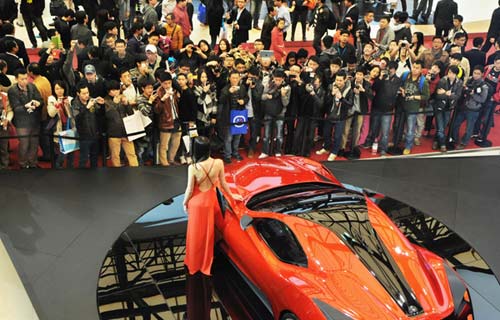Home and art form a perfect union
Updated: 2012-10-12 10:02
By Lin Jing and Su Zhou (China Daily)
|
|||||||||||

He studied tourism management, but now Jiang Peng is decorating property with a special flair
The first time Jiang Peng went to 798 Art Zone in Beijing it was a mere skeleton of what it would eventually become. That was about 2000, and he was looking for a large warehouse for his interior decorating company. But inspired by artistic aspects of 798, Jiang changed course and decided to rebuild the abandoned dining hall into a showroom.
His company, Dara, founded in 1998, was one of the first startups in 798 Art Zone.
The bold decision to open the studio there turned out to be prescient. 798 Art Zone has turned into the biggest modern and contemporary art center in the Chinese mainland, and hundreds of artists, galleries and all kinds of institutions are moving in, seeking opportunities in art and business.
Dara has since become a successful company that attracts the monied classes in particular. Early on, more than 80 percent of its customers were foreign CEOs or ambassadors and that has risen to 10 percent.
"The reason I chose 798 to start my home decorating business was simple," says Jiang, 39. "The low rent and the special environment."
Most of his target customers are the same kind of people who may be interested in 798, he says.
"They have special tastes and they are willing to pay for artistic design. And 798 is a good place for startups to grow.
"In the beginning, many artists or startups here started from nothing. The atmosphere here encourages tourists to find something new instead of something famous."
Jiang says every year Dara makes millions of dollars mainly from interior design and selling furniture, such as sofas, curtains and oil paintings.
Jiang, the company's chief designer, charges up to 1,500 yuan ($240, 180 euros) a square meter for apartments larger than 200 square meters.
Any design client buying 20,000 yuan of furniture from Dara within three months gets 2,000 yuan worth of credit to buy Dara furniture.
Qi Yi, a customer, got to know the company after coming across Jiang's showroom when he visited 798 seven years ago, and his latent interest in the company sparked to life last year when he bought a 300-sq-m house.
Dara provides a mix-and-match style of home decorating in which a Dutch painting, carved tables and chairs and a Thai woodcarving, which may seem like unlikely partners, can be made to work with one another, demonstrating the house owner's rich experience.
"I like the way they decorate their showroom and Jiang's designs," says Qi, 33. "He doesn't focus on his own thoughts but is mindful of people's daily lives, so he can blend our habits into his artwork."
Qi says he paid hundreds of thousands of yuan in design fees, but thinks it was worth it, and Jiang's design helped reduce costs and time.
Jiang studied tourism management and has little training in interior design, but he says he is well acquainted with the market and has a gift for home decoration. It should be the product not just of designers, he says, but also of interaction with clients, who will finally have to live in the place.
"What I can offer is my experience in the field and my aesthetic sense. I don't like to talk about style, because I think clients and I have already reached agreement on that. If not, they would not have chosen Dara I like to talk about their daily lives, such as who will live in the house, what they have for lunch, Chinese style or Western style, and whether they like to host parties."
Tracy Aniere, an Australian designer with Dara, says she was attracted by Dara's style during a casual visit to 798.
"I was taken by the architecture in the district, and particularly loved the Dara showroom when I entered it," says Aniere, who used to work for large property developers such as Sun Hung Kai in Hong Kong.
She says that she was very excited to be involved with Dara. "Jiang Peng has a unique and interesting style, and I feel I can learn a lot from him. He has a way of blending traditional Eastern sensibility and grace with a bold contemporary flair that I really appreciate. And I think art is one of the main inspirations in his work."
Jiang has been a nominee for the Andrew Martin Award, which is highly regarded in the world of interior design, and the design of his own home gained him a place in the Andrew Martin Interior Design Review last year.
Apart from his design work, he gives talks to other designers and is a regular at social events on the local fashion scene. While that kind of exposure can only help him and his company, he says, word-of-mouth is ultimately the best marketing tool.
"The reason I have many foreign clients is that they have a social circle in Beijing and they recommend Dara to their friends."
In the past few years the clientele has changed markedly, he says, and now only 10 percent are foreigners; most are Chinese aged 30 to 40.
As the rich travel overseas more, they become more open to his mix-and-match style of home decoration, he says. "We now have clients willing to spend millions of yuan to have us decorate a villa."
Jiang says it took four years for him to get to the point where customers with little idea of home decorating would give him their total trust. But even if he is doing well out of all of this, he says it has not been that easy. For example, Dara opened half a dozen shops around China but they did not do well and shut down, leaving Jiang to focus on 798.
"We made a mistake because we forgot that the core value of Dara is design, and that cannot be replicated in stores in other cities. It's not a standardized product like fried chicken at KFC."
And even fame, in this case 798's rather than Jiang's, has its downside.
"Many clients don't like coming to Dara as often as they used to because there are too many tourists here," Jiang says. "And the volume of visitors makes it difficult for staff to get on with their work."
Gu Zhenqing, an independent exhibition planner, says that 798 is a good spot for startups to get connected with potential clients.
"798 is an amazing place that people, either officials or business elite, students or white collars, all like to visit. It is also a stage where you can display your work and gain attention."
However, Gu acknowledges that that kind of scene has its drawbacks. Too many people can spend too much time on social activities rather than what they are really there for: to create and disseminate art.
Contact the writers at linjingcd@chinadaily.com.cn and suzhou@chinadaily.com.cn
(China Daily 10/12/2012 page16)
Today's Top News
Rescuers race against time for quake victims
Telecom workers restore links
Coal mine blast kills 18 in Jilin
Intl scholarship puts China on the map
More bird flu patients discharged
Gold loses sheen, but still a safe bet
US 'turns blind eye to human rights'
Telecom workers restore links
Hot Topics
Lunar probe , China growth forecasts, Emission rules get tougher, China seen through 'colored lens', International board,
Editor's Picks

|

|

|

|

|

|





